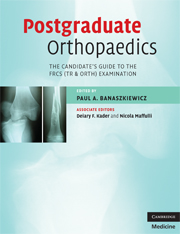Book contents
- Frontmatter
- Contents
- List of contributors
- Foreword by Mr Peter Gibson
- Preface
- Glossary
- Section 1 The FRCS (Tr & Orth) examination
- Section 2 The written paper
- Section 3 The clininicals
- 3 The short cases
- 4 Short case list
- 5 The long cases
- 6 Long case list
- 7 Hand and wrist clinical cases
- 8 Shoulder and elbow clinical cases
- 9 Spine clinical cases
- 10 Hip clinical cases
- 11 Knee clinical cases
- 12 Foot and ankle clinical cases
- 13 Paediatric clinical cases
- Section 4 Adult elective orthopaedics oral
- Section 5 The hand oral
- Section 6 The paediatric oral
- Section 7 The trauma oral
- Section 8 The basic science oral
- Section 9 Miscellaneous topics
- Index
- References
10 - Hip clinical cases
from Section 3 - The clininicals
Published online by Cambridge University Press: 22 August 2009
- Frontmatter
- Contents
- List of contributors
- Foreword by Mr Peter Gibson
- Preface
- Glossary
- Section 1 The FRCS (Tr & Orth) examination
- Section 2 The written paper
- Section 3 The clininicals
- 3 The short cases
- 4 Short case list
- 5 The long cases
- 6 Long case list
- 7 Hand and wrist clinical cases
- 8 Shoulder and elbow clinical cases
- 9 Spine clinical cases
- 10 Hip clinical cases
- 11 Knee clinical cases
- 12 Foot and ankle clinical cases
- 13 Paediatric clinical cases
- Section 4 Adult elective orthopaedics oral
- Section 5 The hand oral
- Section 6 The paediatric oral
- Section 7 The trauma oral
- Section 8 The basic science oral
- Section 9 Miscellaneous topics
- Index
- References
Summary
Ankylosing spondylitis
Introduction
Seronegative inflammatory disease of unknown aetiology primarily affecting younger men. Peripheral joint involvement is less common than spinal disease. The hip joint is involved in 30%–50% patients and is usually bilateral (50%–90%). Typical age of onset is 15–25 years. The younger the age at onset the more severe the disease is likely to be and the more likely the need for THA.
History
As for any inflammatory joint disease, the onset is often insidious and patients typically cannot give a precise time of onset or even pinpoint the initially affected side.
Clinical features
Early on the patient has a “hang-dog posture” (rounding of the shoulders and slight dorsal kyphosis). There is a loss of lumbar lordosis and limited spinal movements in all planes. Later, an advanced stoop develops, with limitation of forward vision (question mark posture). The chin brow angle, occiput to wall distance and gaze angle are used to evaluate functional deformity involving the cervical spine. There is severe loss of motion at the hip joint, a fixed flexion deformity or ankylosis. There is also reduced chest expansion.
Radiographs
Radiographs show ossification of the ligamentous origins and insertions about the trochanters, iliac crest and ischial tuberosities. Later on radiographs become similar to those for end-stage primary osteoarthritis.
Management options
If there is any uncertainty about whether the pain is arising from the hip joint or the spine then a local anaesthetic injection into the hip joint may be useful.
- Type
- Chapter
- Information
- Postgraduate OrthopaedicsThe Candidate's Guide to the FRCS (TR & Orth) Examination, pp. 71 - 104Publisher: Cambridge University PressPrint publication year: 2008



